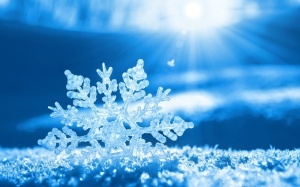 In Part 1, we learned that snow is always changing as it falls from the sky and then as it settles in our snowpack. Although we associate snow with cold, it actually acts as an important insulator for the ground and all of the Colorado critters that live here throughout the winter. Grains of snow trap air that act much like our feather down jackets that keep us warm, insulate the ground, which stays at about 32° F.
In Part 1, we learned that snow is always changing as it falls from the sky and then as it settles in our snowpack. Although we associate snow with cold, it actually acts as an important insulator for the ground and all of the Colorado critters that live here throughout the winter. Grains of snow trap air that act much like our feather down jackets that keep us warm, insulate the ground, which stays at about 32° F.
It is this “warm” temperature at the bottom of the snowpack that drives a change throughout the rest of the layers of snow which modifies our snow grains. Snowflakes break down as they land and come in contact with other grains, and go through a destructive process, in which the delicate arms melt down and the grains turn into what are called “rounds”. These rounds bond very well together, as there is a lot of surface area for them to come in contact with other grains. This snow makes excellent snowballs! But, once buried in the snowpack, a constructive process driven by sublimation occurs. Sublimation is when a snow grain’s frozen water molecules turn from a solid form (ice) straight into the gas form, skipping the liquid phase. When there is a large temperature difference between the different layers of snow, this gas travels upwards through the snowpack. As this humid gas travels up the snowpack and cools down, it refreezes on the stable rounds. These rounds grow angular arms and are then called “facets”. These facets do not bond well with other snow grains because the now pointy grain does not offer much surface area to bond with neighbors. This is snow that does not stick together, and runs through your fingers like sugar.
These different environments in which snow crystals form, and in the snowpack where they metamorphose, create a wide variety of snow conditions. The range in which snow grains bond in Colorado can account for the existence of weak and strong layers, which impact the stability of our snowpack. When these weak, faceted layers get buried by new snow, they are out of sight but should stay in mind, as they tend to persist throughout much of the winter in our relatively shallow snowpack. It is from these weak layers, combined with the right slope angle and a trigger, that avalanches occur.
These snow conditions can tell us a lot about the avalanche danger while out enjoying the backcountry. If you are interested in learning more about this, please take advantage of a variety of local avalanche awareness classes hosted by the Colorado Avalanche Information Center, Vail and Beaver Creek Ski Patrol, Apex Mountain School, Colorado Mountain College, Paragon Guides, and White Room Adventures this winter.
Who knew such a simple thing like a snowflake could have such complex implications in our everyday lives? Even on calm winter days, there is a constant and dramatic shift happening under our feet. Conditions can change from morning to afternoon, day to day, and storm to storm. If there’s one thing we can count on, it is change.
Rose is the Youth Programs Coordinator at Walking Mountains. She would be happy to help you find an Avalanche Awareness class that is just right for you. Contact Rose, rosed@walkingmountains.org









